Chops: Intermediate/Advanced
Theory: Intermediate
Lesson Overview:
• Learn how to create angular, “alien-sounding” arpeggio phrases.
• Develop your left-hand legato skills by using “hammer-ons from nowhere.”
• Understand how Vai uses tapping to create wild and jagged melodies.
Click here to download a printable PDF of this lesson's notation.
In this lesson, I’ll show you some of the characteristic elements in Steve Vai’s playing, and we’ll focus on note choice, technique, and rhythms. This will help you get a better understanding of his unique approach and unmistakable style. Now, these phrases aren’t for the faint of heart, so take your time and work through them slowly. Each example is played at two tempos, slow and fast. Let’s dive right in!
Fig. 1 is similar to a lick Steve played at the beginning of “Shyboy” from David Lee Roth’s Eat ’Em and Smile. I’ve changed a few of the notes to better fit a D7 chord. The D7 acts as the V chord in the key of G. When we play a G major scale starting on D (D–E–F#–A–B–C) we end up in D Mixolydian. This idea travels from the 22nd fret to the 12th fret using pull-offs and slides, and it requires some left-hand control and strength to articulate all the notes. Pick only when crossing strings and follow the suggested fingering to facilitate execution.
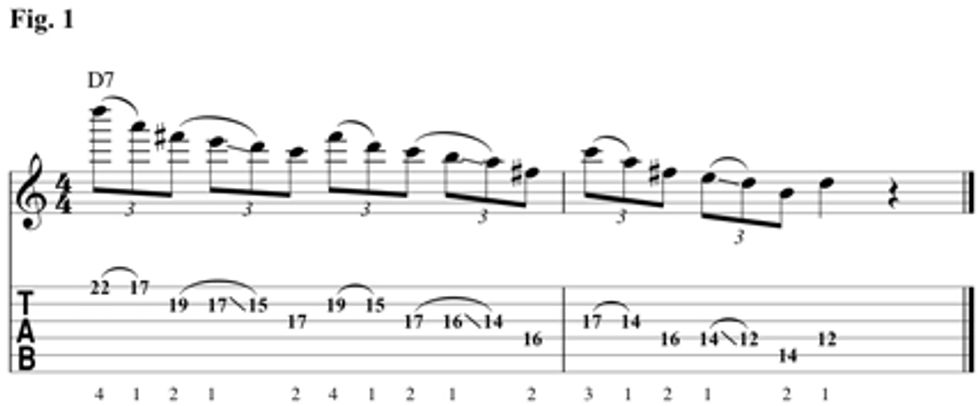
Steve’s use of arpeggios is special. He likes to use the particular shape shown in Fig. 2, and the runs can become quite intense! I’ve simplified the rhythm a bit to make the example easier to practice. The phrase is over Dm7 and uses a D Dorian sound (D–E–F–G–A–B–C). The main structure of this shape consists of five notes played on four strings. This can be seen as a Dm11 arpeggio starting on G, the 11, followed by the root, b3, 5, and b7.

Then it slides up on the 1st string to the second arpeggio on the 15th fret. The shape is identical when compared to the first one, only here it’s an Am11 arpeggio. Now comes the fun part: Use your third finger on the 3rd string to slide up to the next arpeggio starting on the 19th fret. Then play the same shape in that position ascending, slide down with your pinky back to the 15th fret and descend through the same arpeggio shape once again. Grab the A on the 3rd string with your third finger, slide down to the 10th fret, and back up to the 19th fret. Classic Vai!
The idea in Fig. 3 will get your left hand in shape because you can just pick the first note and then throw your pick away! Nah, you better keep it. Played over a Bm7 chord, this run uses the B Dorian mode (B–C#–D–E–F#–G#–A), another of Vai’s typical scale choices. In this three-note-per-string scale approach, most of the work comes from the left hand doing pull-offs. To start with, pick the first note of each string to let your finger get acquainted with the run. Once you’re more comfortable, you can just hammer to the next string down. Make sure you give each note the same value and don’t rush through the pull-offs. Let the legato begin.

When I first saw Steve play the lick in Fig. 4, I thought “So that’s how you do it!” Very ingenious and it sounds great. You can hear something similar on “Die to Live” from Vai’s Alien Love Secrets. Take a two-string power chord (a fifth interval) and start changing strings while moving up the neck. Here’s the breakdown: Bb power chord on the lowest two strings, F power chord on the 5th and 4th strings, C power chord on the 4th and 3rd strings, C inverted power chord (a fourth interval) on the 3rd and 2nd strings, and another C power chord on the top two strings. Finish with a classic one-finger sliding line to complete the sound of the Bbmaj13th chord. Make sure you follow the exact fingering in order to play this one correctly.
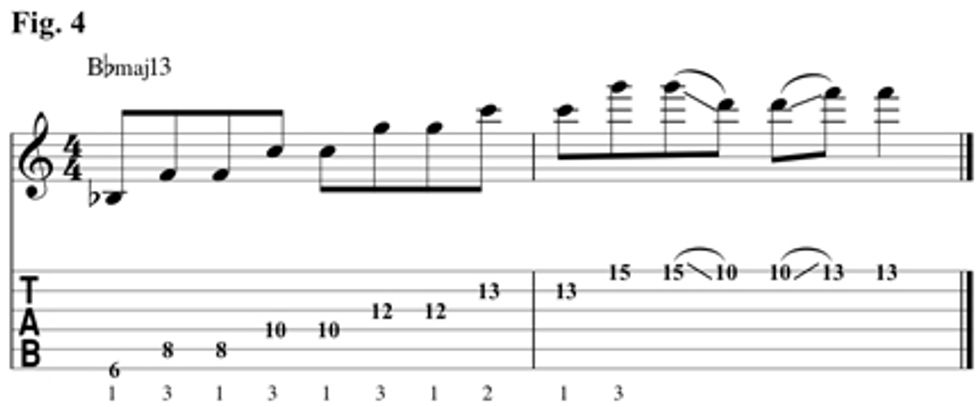
We have some shreddy goodness in Fig. 5—pure alternate picking over an Am7 chord. The scale we are using is A Dorian (A–B–C–D–E–F#–G) or the second mode of the G major scale. There’s no sliding in this lick, just one position shift on the B string, so keep picking!
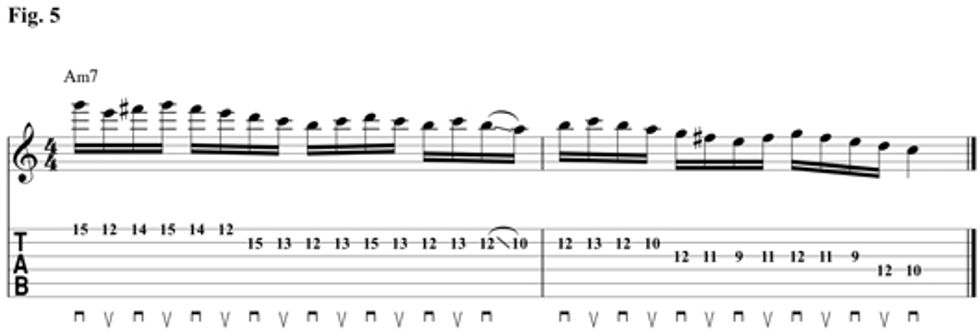
Tapping madness! This lick (Fig. 6) is also from Vai’s David Lee Roth days. It employs symmetrical fingering patterns: Think of the left hand always playing whole-steps through all strings and the tapping right finger following “one side” of a minor pentatonic pattern. The scale is mainly D Dorian, the second mode of C major, over Dm7. Towards the end, he takes some chromatic liberties and moves the fingering in ascending half-steps to finish with a whole-step bend that you have to hammer with your left hand—no time to pick it. And then you have to tap the 20th fret and hold that note. Monster phrase.
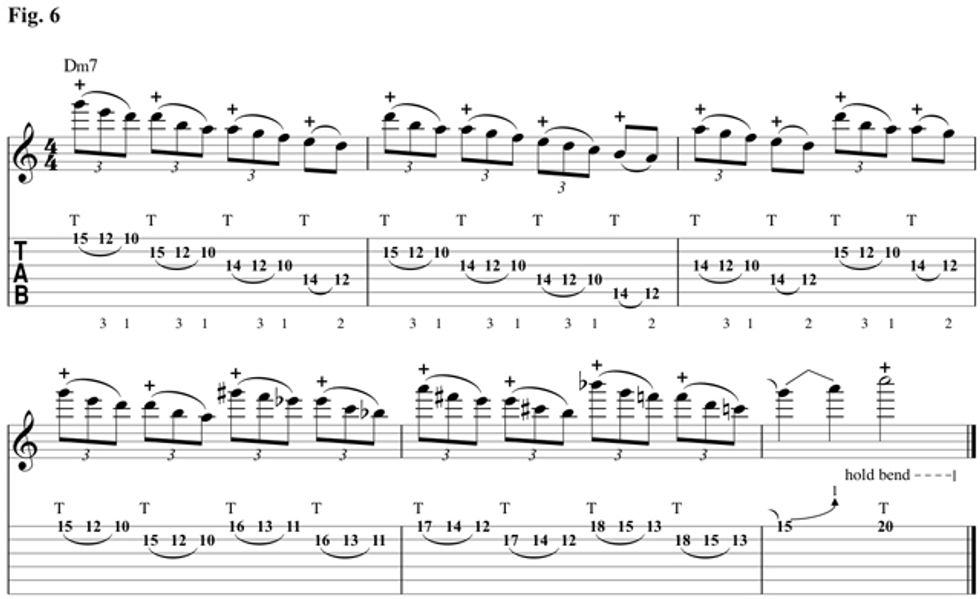
Pay attention to the suggested fingering and also to the fact that not everything is a triplet. I made the tapping hand fall on the downbeats to facilitate the timing of the lick.
One of Vai’s stylistic trademarks is the use of wide intervals. In Fig. 7, we are in F# Dorian (F#–G#–A–B–C#–D#–E). These leaps go beyond two octaves and you have to visualize two fretboard positions simultaneously. The left hand plays a symmetrical position on frets 2 and 4, while the right taps “one side” of a minor pentatonic shape up on the 21st fret. Notice that the tapping does not always fall on the downbeat, creating a very cool rhythmic motif. Pay attention to the suggested fingering, and to avoid creating a triplet when you have three notes on one string, don’t rush the pull-offs. Keep it all in 16th-notes!

The example in Fig. 8 shows how Vai uses the good ol’ blues scale in F# (F#–A–B–C–C#). Note the implementation of “partial picking.” Start with an upstroke, hammer and pull-off the next two notes, and pick the next three starting with a downstroke. Repeat.
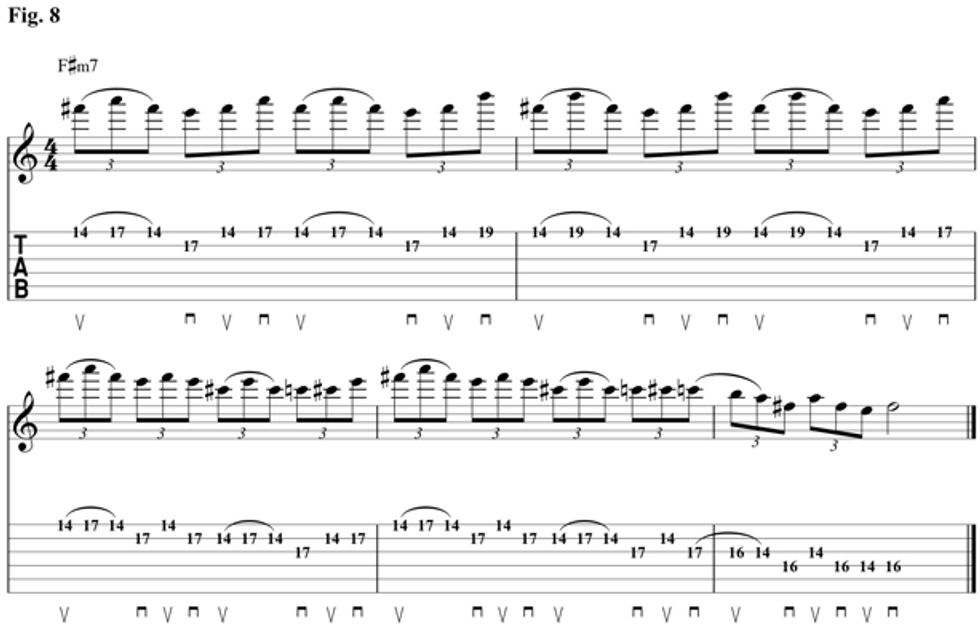
Well folks, I hope I gave you a little insight into Steve Vai’s inventive style and musicality. Keep practicing and transcribe as much as you can!
 A native of Argentina, Ernesto Homeyer has been playing guitar for over 25 years and is a guitar instructor at Musicians Institute in Hollywood, California. In addition to his work as a mixing and mastering engineer for Ultimate Rhythm Studio, he has released four albums with EGH and King Crazy. For more information, visit youtube.com/ernestohomeyer.
A native of Argentina, Ernesto Homeyer has been playing guitar for over 25 years and is a guitar instructor at Musicians Institute in Hollywood, California. In addition to his work as a mixing and mastering engineer for Ultimate Rhythm Studio, he has released four albums with EGH and King Crazy. For more information, visit youtube.com/ernestohomeyer.
















